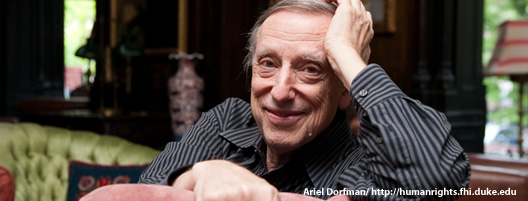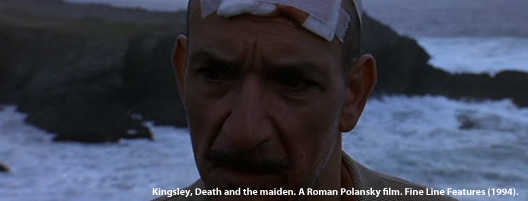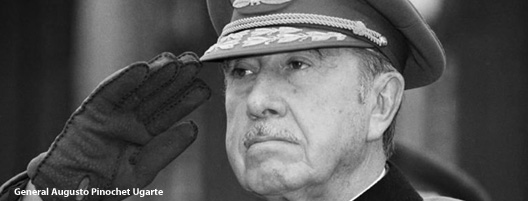DEATH AND THE MAIDEN: HISTORICAL TRAUMA AFTER NATIONAL DOCTRINE SECURITY IN CHILE
By Juan Manuel Zuluaga Robledo*
“Thank you God: I rule country with my hands of iron.
My government is not a dictatorship. If have been
a dictatorship has been a soft dictatorship.
I am democratic man but in my way. I do not believe in
dialogue, that is the game of communists. What is pluralism?
I disagree with that word. It is an indication of
political sanctimoniousness. Human rights are
a very wise invention of communists. I prefer to guarantee
safety of 10 million of inhabitants that
those rights of 10 thousands unreasonable citizens”
(General Augusto Pinochet Ugarte)
National Security Doctrine was the most remarkable army project that coordinated the United States government in Latin America to combat the communist expansion during the Cold War. That Doctrine worked strongly since the end of the Second War II until the democratic transition in the 80; his application was notorious in the 60 and 70, with the beginning of the latinamerican dictatorships. In those days, trauma was a common issue, and people experience the nightmare in a personal perspective, but assume the situation in community, in a collective soul against the dictator´s dispensations.
First, it is necessary to understand that the Doctrine caused millions of traumatic events in Latin America. Then, it is imperative to realize that “Death and the Maiden” is located in times of National Security Doctrine´s decadence in the 80s and the beginning of 90s. We are going to study the political and historical context when occurs traumatic events and how Ariel Dorfman represents trauma in his famous play: the role of Gerardo Escobar as the leader of commission, a Government office in transition time at the 80s that shows her ineffectiveness to find legal solutions to the alive victims of the regimen. Paulina Lorca is a metaphor of traumatized and raped women, a symbol of historical and collective trauma. Roberto Miranda is a symbol of the ordinary perpetrators that still walking free without troubles in the sidewalk of Santiago de Chile, after twenty fourth year of Pinochet regime culmination. They still free and never had troubles with the courts in the austral country. Then it is inappropriate to relate Ariel Dorfman´s play with trauma theories exposed by Saul Friedlander, Sophia A McClennen and Cathy Caruth.
In a historical and political perspective, National Security Doctrine used counterinsurgency methods as torture, violation of human rights, army repression, death forced and the use of intelligence tools to defeat communist enemy. As a consequence, application of the Doctrine may involve irruption of trauma in the communities of victims of the dictatorships. Except for Colombia in the 60s and 70s, the majority of Latin American countries suffered the inclemency of totalitarian political systems. Hugo Banzer in Bolivia, Jorge Rafael Videla in Argentina, Brazilian military regimen (Castello Branco, Artur da Costa Silva, Emílio Garrastazu Médici, Ernesto Geisel, João Figueiredo), Alfredo Stroessner in Paraguay, Juan María Bordaberry in Uruguay and Augusto Pinochet in Chile. Some of these dictators were judged by commissions in the 90s and the beginning of the new millennium. They designed the terrible “Operación Condor” that caused a lot of trauma in the region.
Colombian sociologist Francisco Leal Buitrago suggests that National Security Doctrine it was the most remarkable contemporary military doctrine in the region in the 60s and 70s. In addition, that vision, the military took over the political arena in the region geopolitical influence of the United States government, in that case the Latin American territories (Leal Buitrago: The insecurity in the safety: Colombia 1958-2005. p. 28, Editorial Planeta). The Spanish researcher Pedro Rivas Nieto comments that in the National Security Doctrine, for the military, nation, state and homeland, are the same thing. For them, pacific mass protests, democratic opposition, and citizen that did not agree with their ideas, were categorized as subversive. In that sense, the subversion must be exterminated using the violence and the military force (Rivas Nieto: National Security Doctrine and Military Regimes in Iberoamerica. p. 9, Editorial Club Universitario). For instance, there are a lot of traumatic stories that appeared in that time: Paulina Lorca and Gerardo Escobar are an overwhelming example of it. They are victims of that political system of repression.

The high range of latinamerican military and some important members of the armies of the region as Pinochet studied in military centers of the United States. The most famous it was “La Escuela de las Américas” in Panama. The future dictators studied the strategies to defeat the enemy, the armed subversion while the students analysed the counterinsurgency methods that the French Army practiced during the algerian emancipation in Africa to get information of the enemy (Leal Buitrago, p. 37).
The National Security Doctrine dictates the supression of the communism in the latinamerican countries, the combat against the “guerrilla”; the political opposition, the violation of the political rights and the totalitary invasion of several human life aspects: economics, politics, religion, education, the society, etc. For that reason, it was totalitarian theory.
Besides, The National Security Doctrine was losing power and suffered a context of decadency with the United States government of Carter with the creation of Human Rights Office. That resolution rested support to the latinamerican dictatorships and configurated the context to reach the democratic transition of the countries that lived the repression of the Doctrine.
Ariel Dorfman´s play it is located in the further period after the National Security Doctrine. Dorfman´s book take place thirteen years later when democrat president Jimmy Carter opened the Human Rights Office. Despite the Contras that Ronald Reagan supported in Central America, United States government lost attention in the dictatorships in that period. It were unnecessary for United States interests.
In Chile that situation allowed the creation of the National Comission of Reconcilation and Truth under the leadership of Raúl Rettig in 1990. In that sense, Gerardo Escobar is an alter ego of Rettig. In 1988, Chileans citizens voted in the referendum (Plebiscito Nacional) that Pinoched must retreat to the presidency. However, when the beginning of the new democratic government, Pinochet still acting as the Commander of the Army Forces. For characters as Paulina Lorca in “Maiden and Death”, there is a contradiction that exist a commission while Pinochet served that strong position in the Chilean army.
In that way, Sophia A. McClennen explains that “La muerte y la doncella” that grows out of a very concrete, local event: the establishment of the Chilean truth commission, known as the Rettig Commission, that would only investigate the crimes of the dictatorship that had ended in death or the presumption of death”. Sophia A. McClennen: Torture and Truth in Ariel Dorfman´s (“La muerte y la doncella”. p. 2).
Trauma in that context it is a product of government policy to combat the communism in the region in the 70s and 80s. Trauma acts like a repetition: in “Death and Maiden”, the hypothetical latinoamerican country that author creates —under universal perspective, could occurs in all Latin American countries that lived a dictatorship— it is living a democratic period: The democratic transition in the 80 in the democratic government of Chilean president Patricio Aylwin Azócar, but trauma still alive in Paulina Lorca´s mind. Attorney Gerardo Escobar and his wife are direct victims of National Doctrine Security. They belonged to the political resistance against Pinochet´s dictatorship. Are direct victims as activists and Pinochet´s government did not tolerate any sort of political opposition. For the regimen critics from religion (Teología de la Liberación), the political dissidents, not strictly the communist, communists obviously, guerrilla movements, are in the same side of the problem. The army had the duty to repress and eliminated them.
As an alter ego of Raúl Rettig, Attorney Gerardo Escobar —like a Baltazar Garzón in Spain— is sign of the socialist activist that have the goal to clarify the crimes of the dictatorship against the human rights. The president, an abstract character that symbolize Patricio Aylwin, appointed Escobar to be the leader of the commission that are going to investigate those crimes. An annoyed Paulina Lorca mentions that is the peak of his career in his activist labor. Despite of marital problems, he needs Paulina´s consents for one reason: she is a victim of the regime. She suffered the persecution and brutality of Pinochet´s forces. In Escobar´s point of view, he needs the approving of his wife (a legitimacy) because she is a direct victim of the National Security Doctrine. She is a depository of an historical trauma in Chilean society. She lives in a constant repetition of trauma. She experiences the situation (flashbacks, nightmares) privately while she is a symbol of victim women of Pinochet´s facto government. Here, reader could analyze trauma in a personal perspective with implications in the community of Chilean victims (Dorfman: Death and Maiden. Penguin Plays. p. 8).
Furthermore, Paulina Lorca as victim questions the function of the National Commission of Reconcilation and Truth: that government agency only have jurisdiction in cases of death people and disappeared that cannot speak. What happened with victims that are experiencing trauma like that have a mouth to speak, to testify? Later, when she is using Robert Miranda as therapy, when Paulina is torturing him and expresses that to Gerardo that he is doctor who play “Death and Maiden” and Nietzhe´s issue, the following statement, a testimony that reflect the impotence of Commission to resolve her personal problem and historical trauma: “Do you really think I´d do anything to trouble the Commission, stop you from finding out where the bodies of missing prisoners are, how people were executed, where they are buried. But the memembers of the Commission only deal with dead, with those who can´t speak (Dorfman. p. 37). Besides, she does not believe in the judges that during seventeen years of dictatorship never paid attention to dispatch trauma and find a solution to the victims. In her mind, she considers that judges are allies of Pinochet´s government in a context when Habeas Corpus is inadmissible and is dead letter. (Dorfman. P 10).
What happened with a Commission if Pinochet still ruling army´s destiny, despite of the civilian president? (Dorfman: Death and Maiden. Penguin Plays. p 9). Therefore, Escobar ensures Commission has a limited labor: “Limited, let´s say we´re limited. But there is so much we can do […] We´ll publish our conclusions”. In that sense, Escobar and his legal team only could establish moral sanctions to the perpetrators of the offence. (Dorfman. p. 17). Pinochet still managing the string of the puppet, while raped women cannot calm theirs pains and reproduce constantly trauma in their minds. Paulina is right when she asks about punishment against torturers. She demands not only moral sanctions, she explains that the situations requires the participation of the legal courts that attend her painful case.

When an armed conflict increase the number of victims as happened in Colombia, expert declared the importance of forgiveness and forgotten to overcome historical and collective trauma. The same situation occurred in Chile. In the middle of the confrontation of Dorfman´s, Escobar expresses “no need to smile at him but basically yes, that is what we have to do. And start to live, yes” (Dorfman: p. 39). Nevertheless, she criticizes that posture. She assumes a critical position with the “consensus” that lives the country to combat historical trauma. She cannot forgive. She can cannot forget traumatic events with “Death and the maiden” as soundtrack. She is not in favor with compromise, agreement, negotiation with the torturers, a typical situation of the democratic transition in Chile while perpetrators and the Right controls economy and the Army. She questions that the Commission could investigate crime but is not capable to punish it. She questions directly the democratic transition that is not offering solutions to her as victim of community trauma. She is not agrees with amnesty for tortures as Miranda and Pinochet (Dorfman: p. 39).
On the other hand, Schubert´s Death and the Maiden Masterpiece it is a literary resource that Ariel Dorfman uses to explain the chain of traumatic repetitions that Paulina Lorca suffers in her life. She recognizes Roberto Miranda when he returns to speak with Gerardo. When she has Schubert´s cassette in her hands, she tries to recognize the smell of transpiration in Roberto´s body, she recognizes hypothetically his disgusting laughing (Polansky´s film where Dorfman is the scriptwriter offers that view). She wants to rape him as act of vengeance. With repetition of “Death and Maiden” in her mind, she reproduces trauma again and again. She is a symbol of the community of tortured victims. She is symbol of the repression that caused the National Security Doctrine. With Schubert´s piece she remembers her torture with energy voltages in her body and the fourteen times that she was raped by Roberto Miranda, an intellectual and refined character that enjoys with the good music and the violations of human rights (Dorfman: p. 27). Miranda is a therapy for Paulina. He is the freudian way that she needs to exorcise her traumatic demons. She is using Miranda to testify her trauma, to tell her painful story. But she needs that Miranda testify too. She needs that Miranda declares guilty himself. As a real court —Escobar as an attorney— she is creating historical memory with the recording of the testimony in the cassette. It is the testimony of the victim and the testimony of the torturer. In that ambiguous context, Sophia A. McClennen argues that “Paulina has incontrovertible evidence, but for others it appears that Doctor Miranda is being treated in the same way that Paulina was treated. Paulina uses methods of her torturers to exact a confession from Miranda, then, is she no better?” (McClennen: p. 3). For its part, sometimes Miranda legitimizes the role of the perpetrators. He constantly is criticizing the communist´s actions.

Paulina Lorca and Roberto Miranda are the thesis and the antithesis of the historical trauma in Chile: she as a victim, he as a torturer. Ariel Dorfman did not exclude the two different perspectives to understand the problem: he uses fairly the story of the perpetrators of National Doctrine Security and the testimony of the victims. Saul Friedlander works in “Trauma and transference” with the concept of “Working through”. “Means, first, being aware of both tendencies, allowing for a measure of balance between the two whenever possible. But neither the protective numbing nor the disruptive emotion is entirely accessible to consciousness” (Saul Friedlander: Trauma and Transference: p. 210). For that reason, readers and researcher must understand the phenomenon with both sides of the coin. In Chile of nowadays, twenty four years of Pinochet´s era ending, the population is extremely divided. There a lot people in the high and middle class that believed that Pinochet saved the country from the evil communism, that the dictator did not allow that the Chile became a second Cuba, with the enormous Fidel Castro´s influence. They support the election of president Sebastian Piñera as president two years ago. On the other hand, there is a significant number of citizens that still believing in Salvador Allende´s ideas thirty-eight years after his suicide in el Palacio de La Moneda. For that reason, we need the two versions to understand the historical trauma and the consequences in the community of Chilean victims.
In conclusion, we could study the issue with Cathy Caruth´s ideas. She explains in “Trauma: explorations in Memory” that there are different paths to experience trauma as an individual that lives with it in a community of victims or survivors. In the collective soul, the trauma it is a phenomenon that extends its tentacles during a long time in the Chilean society. Historical trauma still persecuting the community of Chilean victims for a long time after that events occured. With the election of Piñera, trauma still alive in the mind of torture victims of the National Security Doctrine in the austral country. In fact, the victim´s community has been experimenting that historical trauma for the forty sixty years, since Pinochet took the power in September 11/1973.
Some of them —victims of terrible tortures in Estadio Nacional de Chile— live the trauma in a complete silence and suffer in desolation, without the help of the witnessing. The demons of the National Doctrine Security still alive: the victims are making traumatic repetitions, flashbacks in their minds. They still dreaming nightmares of the bloody episodes in the stadium. Ariel Dorfman offers a symbol of the resistance against the impunity, while the perpetrators live an ordinary life in Chile, beneficiaries of amnesty. Dorman created a symbol: Paulina Lorca for the posterity. She is a sign of the historical trauma in the era of the National Security Doctrine. She is a symbol as individual and as victim´s community.
“Death and the maiden”, a film directed Roman Polansky, based in Ariel Dorfman´s play. Video Courtesy Fine Line Features:
[youtube]https://www.youtube.com/watch?v=Cnnz214wwkI[/youtube]
General Pinochet speaks about the communism in Chile and Latin America. Video Courtesy Diario Chileno:
[youtube]https://www.youtube.com/watch?v=P0JQ9pq9Q6s[/youtube]
__________
* Juan Manuel Zuluaga Robledo is the director of www.revistacronopio.com. Is journalist from Universidad Pontificia Bolivariana (Medellín, Colombia). Is master on Political Sciences of the same university and actually is studing a Master in Latinamerican Literature at Illinois State University.

